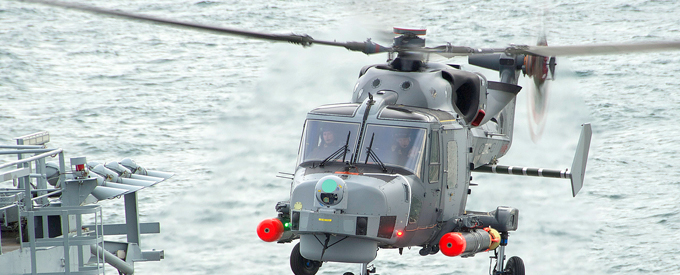2019-12-05
The Multi-role AW159:An All-weather Attack Helicopter
The first international AW159 deliveries were made to the Republic of Korea Navy in 2016. The Wildcat has since logged over 50,000 flight hours having been chosen by the British Army and Royal Navy, the Korean Navy, and the Philippine Navy most recently.
Being able to detect, identify and attack targets autonomously both on land and at sea, the twin-engine multi-role helicopter now conducts multiple missions ranging from constabulary to high-end warfighting. The high-performance AW159 platform features state-of-the-art systems, including a Leonardo Seaspray multi-mode electronically-scanning (E-scan) radar and integrated Defensive Aids Suite.
With the Wildcat, Leonardo has supplied a full spectrum of capabilities, end-to-end from sensors to support. It has been designed from concept to operate safely from the smallest ship decks within the harshest environments, be that poor weather and high sea states.
This technologically advanced aircraft has a fully integrated and comprehensive suite of mission systems operating through a tactical processor facilitating rapid tactical assessment in any theatre, day or night. With a military-derived HMI designed to reduce aircrew workload and increase cockpit capacity, the AW159 delivers excellent situational awareness and mission effectiveness.
The Future Lynx Project
The AW159 Wildcat’s design was originally conceived in response to the MoD’s requirement to replace its legacy Lynx aircraft. The Future Lynx project began in 2002 where it scoped out Surface Combatant Maritime Rotorcraft and Battlefield Light Utility Helicopter requirements.
Four years later, the MoD finalised its contract award and the manufacture of the AW159 began in October 2007. After the maiden flight of the AW159 Lynx Wildcat in 2009, the aircraft conducted its first deck landings on RFA Argus and then HMS Iron Duke in 2011.
The first production AW159 Wildcat was received by the British Army in May 2012, while initial Operating Capability was declared to be on schedule in August 2014, with the Royal Navy following as planned in January 2015, just four years after the maiden flight. Success continued with all aircraft delivered to MoD meeting Full Operation Capability by the end of 2015.
Multi-role All-weather Attack
The AW159 multi-mission maritime helicopter builds on Leonardo’s 50 years of small ship aviation. The aircraft maintains high readiness for long periods, capable of remaining agile to achieve immediate mission prosecution at excellent rates of availability, while being able to launch and recover with minimal disruption to wider ship operations.
This technologically advanced and robust air vehicle boasts comprehensive avionics, mission and weapon systems which are fully integrated to collect and process a considerable amount of information and present it to the crew for the unrivalled situational awareness necessary to achieve competitive advantage in the modern battlespace. With a complete suite of self-protection measures, the AW159 facilitates rapid tactical assessment in any theatre of operations, be that day or night, while it is network-enabled to find, fix and, if necessary, strike at the enemy.
Faced with land and naval targets, this new twin-engine military helicopter is capable of autonomous detection, identification and attack. In addition to war-fighting roles, the highly adaptable AW159 is capable of performing a large variety of missions, including Medical Evacuation, Search and Rescue (SAR), Special Forces or Troop Insertion and Transport of Internal and Underslung Loads for Vertical Replenishment. It can also be equipped with weapons providing autonomous full spectrum Maritime Interdiction, Anti-Submarine Warfare and Anti-Surface Warfare capability, whilst the integrated Radar and Electro-Optical Device enables the helicopter to locate, verify and engage potential threats at stand-off ranges.
The AW159 has a fully integrated and comprehensive suite of mission systems operated through a Tactical Processor. Meanwhile, the Human Machine Interface is designed to reduce aircrew workload and increase cockpit capacity improving situational awareness and mission effectiveness.
The Wildcat is designed with high levels of survivability and crashworthiness thanks to ballistic tolerant design, self-sealing fuel tanks and armoured protection alongside a range of mission and role equipment providing a true multi-role capability in maritime, littoral and land environments. Its short readiness times and high availability rates ensure the helicopter is ready for operations in the harshest maritime environment, extending the area of interest and operational effect of maritime commanders.
The compact AW159 is a fully marinised aircraft, optimised for operations from limited space on vessels in high sea states. With the essential qualities of a robust air vehicle boasting a high Ship Air Interface, the Wildcat’s offers a low footprint of support to secure consistently # safe and regular operations without reliance on a logistics train.
Reference Text/Photo:


No Comments